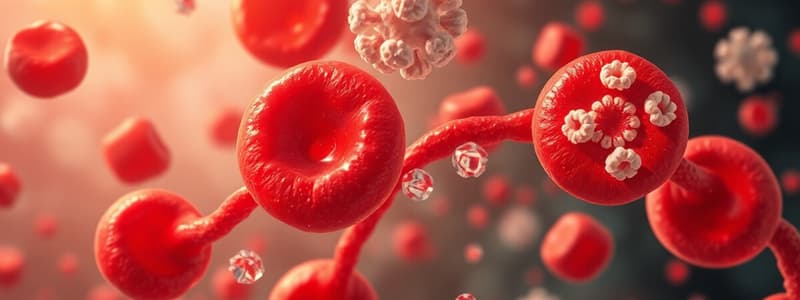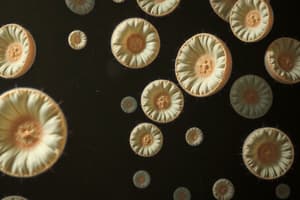Podcast
Questions and Answers
What is the role of the sinoatrial node in the heart?
What is the role of the sinoatrial node in the heart?
- To serve as a valve between the atria and ventricles
- To regulate blood flow to the lungs
- To initiate the contraction of the ventricles
- To act as the primary pacemaker of the heart (correct)
Which valves are responsible for closing during ventricular contraction?
Which valves are responsible for closing during ventricular contraction?
- Atrioventricular valves (correct)
- Semilunar valves
- Pulmonary valves
- Aortic valves
What is the function of lymph nodes in the lymphatic system?
What is the function of lymph nodes in the lymphatic system?
- To cleanse lymph and activate T and B cells (correct)
- To drain excess fluid from tissues
- To produce red blood cells
- To transport oxygen throughout the body
Which statement describes the difference between innate and adaptive immunity?
Which statement describes the difference between innate and adaptive immunity?
What structure helps push the fetus out during childbirth?
What structure helps push the fetus out during childbirth?
What is the primary role of platelets in the blood?
What is the primary role of platelets in the blood?
Which type of white blood cell primarily increases in response to bacterial infections?
Which type of white blood cell primarily increases in response to bacterial infections?
Which statement accurately describes the composition of plasma?
Which statement accurately describes the composition of plasma?
What is the role of lymphocytes in the blood?
What is the role of lymphocytes in the blood?
Where do B cells mature in the human body?
Where do B cells mature in the human body?
What process describes the formation of platelets?
What process describes the formation of platelets?
Which type of white blood cell is known to increase in response to allergies?
Which type of white blood cell is known to increase in response to allergies?
Which protein contributes the most to blood viscosity and osmolarity?
Which protein contributes the most to blood viscosity and osmolarity?
Flashcards
Blood Components
Blood Components
Blood is composed of formed elements (cells and fragments) and plasma (fluid).
White Blood Cell Types (Granulocytes)
White Blood Cell Types (Granulocytes)
Granulocytes are white blood cells with granules; include Basophils, Eosinophils, and Neutrophils.
Platelet Formation
Platelet Formation
Platelets are formed from fragments of megakaryocytes in bone marrow and then enter the bloodstream.
Plasma Components
Plasma Components
Signup and view all the flashcards
Eosinophils role
Eosinophils role
Signup and view all the flashcards
Blood Protein Types
Blood Protein Types
Signup and view all the flashcards
Leukopenia
Leukopenia
Signup and view all the flashcards
Lymphocyte Function
Lymphocyte Function
Signup and view all the flashcards
Pulmonary Circuit
Pulmonary Circuit
Signup and view all the flashcards
Systemic Circuit
Systemic Circuit
Signup and view all the flashcards
Heart Pacemaker
Heart Pacemaker
Signup and view all the flashcards
Lymphatic Duct Drainage
Lymphatic Duct Drainage
Signup and view all the flashcards
Innate Immunity
Innate Immunity
Signup and view all the flashcards
Study Notes
Blood Formed Elements
- Erythrocytes (red blood cells) make up 40% of blood
- Leukocytes (white blood cells) are 1%
- Platelets (fragments of bone marrow)
- Plasma (clear fluid) is 55%
White Blood Cell Counts & Functions
-
White blood cells enter connective tissue to fight pathogens
-
Granulocytes (BEN):
- Basophils: stable, increase with chickenpox, sinusitis, diabetes, and polycythemia; large, irregular shape
- Eosinophils: 10-14 µm, fluctuate throughout the day and the season, increase with parasites, infection, allergies, and collagen/spleen disease, two lobes connected by a thin strand
- Neutrophils: 9-12 µm (Zits), increase with bacterial infections, 3-5 lobes in s or c shape
-
Agranulocytes:
- Monocytes: 12-15 µm, increase with viral infections and inflammation
- Lymphocytes: 2,200 cells, increase with diverse infections and immune responses
Blood Proteins
- Albumins (60%): help heal wounds, maintain blood viscosity and osmolarity
- Globulins (36%): transportation
- Fibrinogen (4%): inactive precursor to blood clots, lasts 14 days without food and 3 days without water
Blood Production
- Thrombopoiesis: Production of platelets
- Hematopoietic stem cells become megakaryoblasts
Plasma Components
- Water makes up most of the plasma
- Proteins, nutrients, electrolytes, nitrogenous wastes, and hormones are all present
Granular White Blood Cells
- Basophils
- Eosinophils
- Neutrophils
Antibody Secreting Cells
- Lymphocytes
B and T-Cell Maturation
- B cells mature in the bone marrow
- T cells mature in the thymus
Platelets
- Platelets come from megakaryocytes
- They aid in blood clotting
- Functions include vasoconstriction, clot dissolving, white blood cell attraction, bacterial destruction, and stimulating mitosis for healing
Leukopenia
- Blood cell deficiency
- Possible causes include heavy metal poisoning or radiation exposure
Pulmonary and Systemic Circulation
- Pulmonary: blood flow from right heart to the lungs
- Systemic: blood flow from the left heart to all organs
Heart Valves
- Atrioventricular valves close when ventricles contract; semilunar valves close when ventricles relax
Heart Pacemaker
- Sinoatrial (SA) node
Heart Contraction
- Systole = contraction
- Diastole = relaxation
- Heart can sometimes regenerate
Lymphatic System
- Lymph flows one way
- Right lymphatic duct drains the right side of the body, thoracic duct drains the left
- Lymph contains neutrophils, NK cells, T cells, and B cells
Immunity
- Innate immunity is quick, characterized by fever, inflammation
- Adaptive immunity takes 5-7 days; B cells & antibodies, and cytotoxic T cells
Cell Production
- Germ cells make sperm
Body Fluids
- Fructose is a sugar used by sperm
Cancer
- Breast cancer is a common tumor in women
- Testicular cancer is a common tumor in young men
Menstruation and Childbirth
- Females experience their first menstruation
- Myometrium (smooth muscle) pushes out a fetus during childbirth
Studying That Suits You
Use AI to generate personalized quizzes and flashcards to suit your learning preferences.




